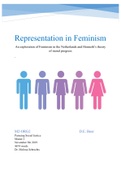Representation in Feminism
An exploration of Feminism in the Netherlands and Honneth’s theory
of moral progress
M2-ORG2 D.E. Boer
Pursuing Social Justice
Master 2
November 5th 2019
4674 words
Dr. Melissa Sebrechts
,Inhoud
Introduction...........................................................................................................................................2
Historical overview of feminism............................................................................................................4
First-wave feminism: women’s suffrage............................................................................................4
Second-wave feminism: freedom and autonomy..............................................................................5
Third-wave feminism: recognition and identity.................................................................................6
Fourth-wave feminism: representation and intersectionality...........................................................7
Theoretical debate on representation...................................................................................................9
The concept of representation..........................................................................................................9
Honneth’s theory of moral progress................................................................................................10
Honneth’s view on representation..................................................................................................11
Conclusion...........................................................................................................................................12
References...........................................................................................................................................13
The image at the front page is retrieved on November 5, 2019, from: https://www.huffpost.com/entry/gender-
identity-respect_n_5a0daf8ee4b0b17e5e1483d4
1
, Representation of the world, like the world itself, is the work of men; they describe it from
their own point of view, which they confuse with the absolute truth – Simone de Beauvoir1
Introduction
This year it has been a hundred years since the approval of the law for active women’s
suffrage in the Netherlands.2 This new law states that women may be elected and vote on
other candidates during elections in a democratic society. This law was a direct result of first-
wave feminism3 where the focus lied on redistribution issues. The past hundred years more
feministic waves followed, where women and men fought among other things for sexual
freedom, financial possibilities, and self-development. Women and men in these second and
third feministic waves have fought for the recognition of every individual, no matter what his
or her background, belief, or sexual orientation. The shift from retribution issues to
recognition issues ‘’can be seen as the cultural turn’’ (Fraser, 2007, p. 24). And now, in 2019,
it has been a hundred years since the introduction of active women’s suffrage in the
Netherlands and several feministic waves.
But still, only 50 of the 150 individuals in the 2 nd chamber in the Netherlands are
female.4 And there aren’t even numbers of how many of those 150 aren’t white, male, and
heterosexual. This can be seen as problematic in this modern society where people strive for
equal opportunities regardless of their age, gender, sexual orientation, or ethnicity (Wolters &
de Graaf, 2009). How come this isn’t a broad national discussion? After all, the idea of a
women quota is a hot topic in political debate in the Netherlands. The opinion of several
political parties, including D66 and Groenlinks, is that more women should be at the top of
big companies and in politics itself. Since 2013 the 5000 biggest companies must strive for at
least 30% female CEO’s. ‘’A quota is needed’’, says 2nd chamber member Vera Bergkamp,
‘’because the progress is too slow at the moment’’. 5 A women’s quota is a way to improve
1
(1953, p, 143). See references for the complete source.
2
Atria. (2019, januari 1). Vrouwenkiesrecht in Nederland. Retrieved October 31, 2019, from https://atria.nl/nieuws-
publicaties/internationaal-nationaal/vrouwenkiesrecht/vrouwenkiesrecht-in-nederland/
3
In this paper feminism should be interpreted as broad term. It will refer to a (women’s) movement for social justice and
gender equality as well as a political debate and theoretical research field.
4
Parlement.com (n.d.) Vrouwen in de Tweede Kamer. Retrieved October 31, 2019, from
https://www.parlement.com/id/vh8lnhrre0zv/vrouwen_in_de_tweede_kamer
5
Binnenlandredactie. (2019, september 12). D66 wil vrouwenquotum voor bestuurders topbedrijven. Algemeen Dagblad.
Retrieved October 31, 2019, from https://www.ad.nl/binnenland/d66-wil-vrouwenquotum-voor-bestuurders-
topbedrijven~a5cd5d2e/?referrer=
2





